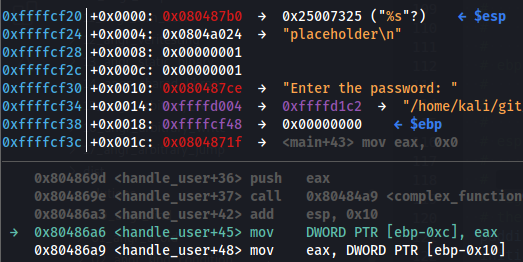6.4 KiB
6.4 KiB
Angr - Examples
Input to reach address indicating the address
import angr
import sys
def main(argv):
path_to_binary = argv[1] # :string
project = angr.Project(path_to_binary)
# Start in main()
initial_state = project.factory.entry_state()
# Start simulation
simulation = project.factory.simgr(initial_state)
# Find the way yo reach the good address
good_address = 0x804867d
# Avoiding this address
avoid_address = 0x080485A8
simulation.explore(find=good_address , avoid=avoid_address ))
# If found a way to reach the address
if simulation.found:
solution_state = simulation.found[0]
# Print the string that Angr wrote to stdin to follow solution_state
print(solution_state.posix.dumps(sys.stdin.fileno()))
else:
raise Exception('Could not find the solution')
if __name__ == '__main__':
main(sys.argv)
Input to reach address indicating prints
# If you don't know the address you want to recah, but you know it's printing something
# You can also indicate that info
import angr
import sys
def main(argv):
path_to_binary = argv[1]
project = angr.Project(path_to_binary)
initial_state = project.factory.entry_state()
simulation = project.factory.simgr(initial_state)
def is_successful(state):
#Successful print
stdout_output = state.posix.dumps(sys.stdout.fileno())
return b'Good Job.' in stdout_output
def should_abort(state):
#Avoid this print
stdout_output = state.posix.dumps(sys.stdout.fileno())
return b'Try again.' in stdout_output
simulation.explore(find=is_successful, avoid=should_abort)
if simulation.found:
solution_state = simulation.found[0]
print(solution_state.posix.dumps(sys.stdin.fileno()))
else:
raise Exception('Could not find the solution')
if __name__ == '__main__':
main(sys.argv)
Registry values to reach address
# Angr doesn't currently support reading multiple things with scanf (Ex:
# scanf("%u %u).) You will have to tell the simulation engine to begin the
# program after scanf is called and manually inject the symbols into registers.
import angr
import claripy
import sys
def main(argv):
path_to_binary = argv[1]
project = angr.Project(path_to_binary)
# Address were you want to indicate the relation BitVector - registries
start_address = 0x80488d1
initial_state = project.factory.blank_state(addr=start_address)
# Create Bit Vectors
password0_size_in_bits = 32 # :integer
password0 = claripy.BVS('password0', password0_size_in_bits)
password1_size_in_bits = 32 # :integer
password1 = claripy.BVS('password1', password1_size_in_bits)
password2_size_in_bits = 32 # :integer
password2 = claripy.BVS('password2', password2_size_in_bits)
# Relate it Vectors with the registriy values you are interested in to reach an address
initial_state.regs.eax = password0
initial_state.regs.ebx = password1
initial_state.regs.edx = password2
simulation = project.factory.simgr(initial_state)
def is_successful(state):
stdout_output = state.posix.dumps(sys.stdout.fileno())
return 'Good Job.'.encode() in stdout_output
def should_abort(state):
stdout_output = state.posix.dumps(sys.stdout.fileno())
return 'Try again.'.encode() in stdout_output
simulation.explore(find=is_successful, avoid=should_abort)
if simulation.found:
solution_state = simulation.found[0]
solution0 = solution_state.solver.eval(password0)
solution1 = solution_state.solver.eval(password1)
solution2 = solution_state.solver.eval(password2)
# Aggregate and format the solutions you computed above, and then print
# the full string. Pay attention to the order of the integers, and the
# expected base (decimal, octal, hexadecimal, etc).
solution = ' '.join(map('{:x}'.format, [ solution0, solution1, solution2 ])) # :string
print(solution)
else:
raise Exception('Could not find the solution')
if __name__ == '__main__':
main(sys.argv)
Stack values to reach address
# Put bit vectors in th stack to find out the vallue that stack position need to
# have to reach a rogram flow
import angr
import claripy
import sys
def main(argv):
path_to_binary = argv[1]
project = angr.Project(path_to_binary)
# Go to some address after the scanf where values have already being set in the stack
start_address = 0x8048697
initial_state = project.factory.blank_state(addr=start_address)
# Since we are starting after scanf, we are skipping this stack construction
# step. To make up for this, we need to construct the stack ourselves. Let us
# start by initializing ebp in the exact same way the program does.
initial_state.regs.ebp = initial_state.regs.esp
# In this case scanf("%u %u") is used, so 2 BVS are going to be needed
password0 = claripy.BVS('password0', 32)
password1 = claripy.BVS('password1', 32)
# Now, in the address were you have stopped, check were are the scanf values saved
# Then, substrack form the esp registry the needing padding to get to the
# part of the stack were the scanf values are being saved and push the BVS
# (see the image below to understan this -8)
padding_length_in_bytes = 8 # :integer
initial_state.regs.esp -= padding_length_in_bytes
initial_state.stack_push(password0)
initial_state.stack_push(password1)
simulation = project.factory.simgr(initial_state)
def is_successful(state):
stdout_output = state.posix.dumps(sys.stdout.fileno())
return 'Good Job.'.encode() in stdout_output
def should_abort(state):
stdout_output = state.posix.dumps(sys.stdout.fileno())
return 'Try again.'.encode() in stdout_output
simulation.explore(find=is_successful, avoid=should_abort)
if simulation.found:
solution_state = simulation.found[0]
solution0 = solution_state.solver.eval(password0)
solution1 = solution_state.solver.eval(password1)
solution = ' '.join(map(str, [ solution0, solution1 ]))
print(solution)
else:
raise Exception('Could not find the solution')
if __name__ == '__main__':
main(sys.argv)
In this scenario, the input was taken with scanf("%u %u") and the value "1 1" was given, so the values 0x00000001 of the stack come from the user input. You can see how this values starts in $ebp - 8. Therefore, in the code we have subtracted 8 bytes to $esp (as in that moment $ebp and $esp had the same value) and then we have pushed the BVS.
